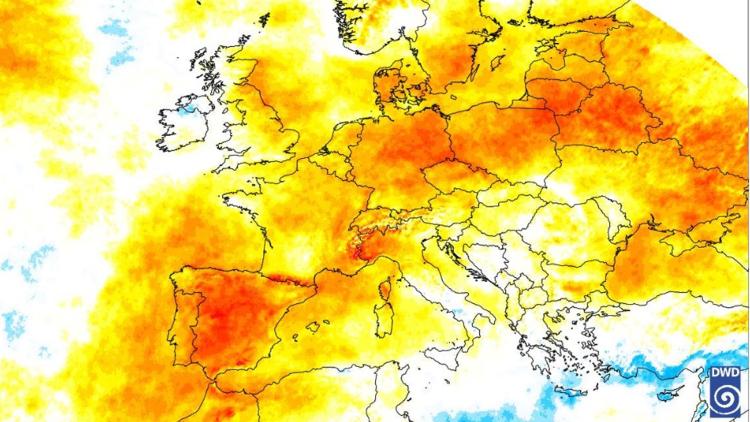
Discussing Iceland’s severe winter weather
Earlier this year we had the pleasure of hosting Elín Björk Jónasdóttir, meteorologist at the Icelandic Meteorological Office (IMO).


Elín visited our HQ in Darmstadt to discuss how satellite data impacts the work of herself and her colleagues, we also got some insight into just how windy Iceland can be!
09 March 2021
28 April 2020
Whilst visiting, she took the time to answer some questions on her role and responsibilities – we hope you enjoy our chat!

Could you give us an overview of your role and your day-to-day tasks?
I oversee the forecasters here at the IMO in Reykjavík and the weather observers at Keflavík Airport. I take shifts as a forecaster and also act as a warning coordinator when needed. I also oversee the training of new forecasters. Some of my time is also spent doing outreach for the IMO, both in the area of forecasting and climate change communication.
How long have you been working in this role?
I started as the Head of Weather Services in January 2017, but had been a coordinator of general weather services since 2015.
How did you become interested in this field?
I took an introduction to meteorology class during my second year of junior college and my interest grew from there, but I also realised that I had been leaning towards physical sciences and environmental sciences since I was little. I just didn’t quite know it then.
What would you classify as “severe winter weather”?
For Iceland, severe winter weather usually includes very strong winds, blizzard conditions and possibly avalanches. In the process, a very warm air mass with high winds and rain can cause equally severe impacts if there is a lot of ice or snow on the ground already. Mostly, the high winds are a common denominator.
What other kinds of weather do you monitor/services does the IMO provide?
The IMO is a multi-hazard monitoring institution and so we monitor weather, hydrology, earthquakes and volcanoes, along with avalanches and land/mud slides.
Do you cover only Iceland or other areas?
We cover Iceland, the Iceland Oceanic Exclusive Economic Zone and the Reykjavík Aviation Control Area/Flight information region, which are the aviation control areas. Our area is very large, one of the largest ones in the world. It covers Greenland, up to the North Pole and to the east over the Faroe Islands.
Is there a particular part of Iceland that experiences more severe weather than anywhere else?
As far as compounding events go, the south coast has severe weather, high seas, earthquakes and most of the volcanoes, however blizzard and avalanche conditions are most common in the north and east.

Could you talk about how you work directly with EUMETSAT data and how that data directly impacts your work at the IMO?
We actually get most of our weather satellite data from EUMETSAT. We use it every day to monitor the position of lows and highs around the country, the location of sea ice and ice on the ground. We also use satellite imagery to view and track dust and volcanic ash. What people may not know is that data from satellites is also extremely important to weather models, where it is used to give accurate observations from the ground in data-scarce areas such as the North Atlantic.
How does the work at the IMO affect society at large and what kind of information, warnings, statistics etc. are made public?
We issue weather warnings, which are impact-based and colour-coded for all 11 forecasting regions. We issue warnings for avalanches and volcanic eruption if they give any known precursors (some volcanoes do, others don’t). We issue hydrologic warnings about flooding of rivers or streams and are in good contact with Icelandic Civil Protection Authorities.
Has your role changed much since you started?
My role has not changed very much since I started, as it is a relatively new position so I’ve been able to mould it into what I felt was needed after my experience as a forecaster and from working in other parts of the IMO.
Will EUMETSAT’s next-generation satellites and new instruments have a direct impact on the work at the IMO and what difference will they make to the accuracy of your reporting?
Better resolution will have an impact, both for monitoring and probably also for forecasting. We rely heavily on polar-orbiting satellites so the new EUMETSAT Polar System – Second Generation (EPS-SG) satellites will increase our monitoring capabilities. Geostationary satellites monitor Iceland, and we are at the edge of the disc, so I do expect we can use quite a lot of what the Meteosat Third Generation (MTG) has to offer to increase the forecast skill and monitoring capabilities over our marine and aviation areas.
What do you enjoy most about the role and what challenges do you face in your work for the IMO?
I enjoy doing practical sciences and training new people to do the important work we do at the IMO. Communication of hazards and risks are the most challenging objective these days.

Do you get any kind of feedback from users or members of the public that benefit from your data? If so, what kind of feedback do you get?
Yes, we do send out surveys to different user groups every 2-3 years and mostly get very good feedback, along with some ideas of what we can do better. We use the feedback when we are planning our next projects.
Finally, what advice would you give to somebody who would like to follow in your footsteps?
It turns out that most of the challenges of being a team leader for forecasters requires skills that we don’t necessarily learn in meteorology school, so I advise anyone to learn more about communications, negotiations and project management. But first and foremost, it is important to have worked on the floor as a forecaster in all kinds of weather and high stress situations. It is difficult to get the best out of a group if you don’t understand the challenges they face.
We’re always happy to share stories from users of our data so a big thanks to Elín for taking the time to share her experiences with us. Do you have your own story to tell? Get in touch: press@eumetsat.int



